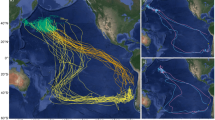Abstract
THE discovery of Kemp's loggerhead in the Azores is of considerable interest, but we obviously still need much more information before we can do more than guess at the causes underlying the movements of these turtles. Among other things, it is essential to discover whether the species is resident around these western islands, for it is quite possible that the single young one found there is a stray similar to those which reach the British coast. The Azores, like the British Isles, lie within the area to which larval eels are carried from their breeding grounds in the western Atlantic. Is it possible that there may be a correlation between the migration of Leptocephalus and the movements of these turtles? Or is it a coincidence that ‘glass-eels’ (larval stage 5) appear off the Spanish coast in September and October, off Ireland in November, and that turtles are stranded on the south-western coast of Great Britain in November and December?
Similar content being viewed by others
References
Linnæus, “Syst. Nat.", 10th ed. (1758).
idem, op. cit., 12th ed. (1766).
Schoepff, “Historia Testudinum” (1792).
LacépÃde, “Hist. Nat. Quad. Orip.", 1, 95 (1788).
Bonnaterre, “Encycl. Méthod., Erpét", 20 (1789).
Daudin, “Hist. Nat. Rept.", 2, 51 (1802).
Author information
Authors and Affiliations
Rights and permissions
About this article
Cite this article
PARKER, H. The Mexican Loggerhead in Europe. Nature 144, 156–157 (1939). https://doi.org/10.1038/144156b0
Issue Date:
DOI: https://doi.org/10.1038/144156b0
- Springer Nature Limited
This article is cited by
-
Names of some Atlantic Loggerhead Turtles
Nature (1939)





